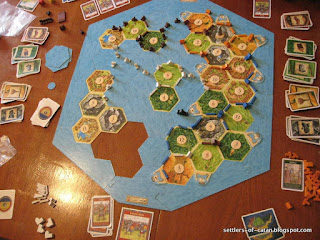Richard rolled the higher number, so - according to our two-player Settlers house rules - he would place his first settlement, then I would place two (taking resources cards for one of them) then he would place two more (taking resource cards for both) and I would then place my final one, taking resource cards for that too. We allow nine in a hand before the robber can attack, and two or three robber-free rounds at the beginning anyway.
Richard said that he was going to use 'my' strategy of starting on the best hex for whichever resource was likely to be scarcest. As it happened, there weren't any obviously lacking resources on this board, but I thought clay and wood would be the most problematical. So I expected Richard to start on either the 4-clay or the 9-wood; most likely, I thought, the useful 5-9-10 combination with sheep, wood and clay respectively.
However, to my surprise, he didn't take either of my chosen spots - instead he opted for the 3-4-8 with wood (on three only) and two ore. That meant that I could place my first two settlements on the two spots I had marked out as the best ones, which gave me five good numbers and access to all five resources.
Richard then took the 5-9-10 with two wheat and wood, and - after some consideration - the 3-4-8 with two clay and a sheep. He liked that spot, which was undoubtedly the best remaining one for clay, but didn't like the fact that it had exactly the same number combination as his first settlement.
As I looked for a spot to place my final settlement, my main aim was access to an 8, since I already had 4, 5, 6, 9 and 10. Since I like having good ore access, I opted for the 8-10-desert hex with ore on 8 and wood on 10. The wood harbour looked rather attractive and convenient too.

Clay and wood were not lacking in the early stages of the game, so we placed streets, and Richard bought a few development cards too. 9s were not rolled, which was a bit annoying since it meant that I could not build a settlement, having no wheat - and nor could I buy any cards. I had to trade four ore, at one point, for one wheat in order to take the sheep harbour, and then trade heavily again for my second settlement.
Then suddenly we rolled three nines in a row, and, with plentiful ore, I was able to build my first city.
However, I had made a strategic error in not securing a spot on the wood harbour; I placed my first two streets next to the other two I had started with, leaving the way open for Richard, who was collecting a lot of wood and clay, to race past me for the wood harbour:

I was ahead at this point in the game (six points, while Richard had four) but he had already played a knight, and had two or three other hidden development cards. As with the last game we played, we decided that the robber would be controlled by whoever rolled a seven (rather than whoever was behind in points) and also that the robber would always steal from the bank - rather than the other player - a resource matching whatever hex he was placed on.
I really wanted a spot on that 5-wheat hex, since wheat was my weak point in this game. Richard had in fact placed his initial settlements as if he were using the 'ore-wheat' strategy, and was beginning, as a result, to get ahead. So I played him at his game, storing up clay and wood until I could push past him to the 2-5 wheat spot on the coast. In doing so, I took the longest street card... for about twenty seconds. Richard then built more streets and took it from me, for the rest of the game.

So I still had six points, while he now had nine. He had also played two knights, so was likely to achieve the 'largest army' too.
And, indeed, that's what happened. We both continued building on just about every turn - in fact Richard reached 16 points before either of us had realised it, and so won the game with 17 points, including both the largest army and the longest street:

I did have one victory point, so I lost with 11 rather than just the ten points I had on the board.










































